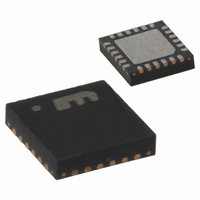MICRF405YML TR Micrel Inc, MICRF405YML TR Datasheet - Page 12

MICRF405YML TR
Manufacturer Part Number
MICRF405YML TR
Description
868-915 MHz ISM Band Transmitter
Manufacturer
Micrel Inc
Datasheet
1.MICRF405YML_TR.pdf
(46 pages)
Specifications of MICRF405YML TR
Frequency
290MHz ~ 980MHz
Applications
ISM
Modulation Or Protocol
ASK, FSK
Data Rate - Maximum
200 kbps
Power - Output
10dBm
Current - Transmitting
18mA
Data Interface
PCB, Surface Mount
Antenna Connector
PCB, Surface Mount
Voltage - Supply
2.2 V ~ 3.6 V
Operating Temperature
-40°C ~ 125°C
Package / Case
24-MLF®, QFN
Operating Temperature (min)
-40C
Operating Temperature (max)
125C
Operating Temperature Classification
Automotive
Product Depth (mm)
4mm
Product Length (mm)
4mm
Operating Supply Voltage (typ)
2.5/3.3V
Operating Supply Voltage (max)
3.6V
Lead Free Status / RoHS Status
Lead free / RoHS Compliant
Features
-
Memory Size
-
Lead Free Status / Rohs Status
Compliant
Other names
576-1965-2
MICRF405YMLTR
MICRF405YMLTR
MICRF405YMLTR
MICRF405YMLTR
Writing to n Registers having Non-Incremental
Addresses
Registers with non-incremental addresses can be
written to in one write-sequence as well. Example of
non-incremental addresses: “0,1,3”. However, this
requires more overhead, and the user should
consider the possibility to make a “continuous”
update, for example, by writing to “0,1,2,3” (writing
the present value of “2” into “2”). The simplest
firmware is achieved by always writing to all
registers. Refer to previous sections.
This write-sequence is divided into several sub-
parts:
Refer to the previous sections for how to write to 1 or
n (with incremental addresses) registers in the
MICRF405.
Reading from the Control Registers in MICRF405
The “read-sequence” is:
It is possible to read all, 1 or n registers. The
address to read from (or the first address to read
from) can be any valid address (0-29). Reading is
not destructive, i.e., values are not changed. The
SIO line is output from the MICRF405 (input to user)
for a part of the read-sequence. Refer to procedure
description below.
A read-sequence is described for reading n
registers, where n is number 1-30.
April 2006
Micrel
• Disable the generation of load-signals by
• Repeat for each group of register having
• Finally, enable and make a load-signal by
1. Enter address and R/W bit
2. Change direction of SIO line
3. Read out a number of octets and change SIO
clearing bit “load_en” (D0 in ControlRegister0)
incremental addresses:
- Bring SEN active
- Enter first address for this group, R/W bit and
- Bring SEN inactive
setting “load_en”
direction back again.
values
12
In Figure 4 above, 1 register is read. The address is
A6, A5, … A0. A6 = MSB. The data read out is D7,
D6, …D0. The value of the R/W bit is always “1” for
reading.
Reading from the Interrupt Register
If any of the interrupts, Vc_HI, Vc_LO or Low_Batt,
is set the SRV pin will go high. Read the interrupt
register, address 24, to see which interrupts are
flagged. It is possible to read this register at all
times, for instance, to read the tuned VCO_FREQ
setting which is also stored at the same address.
When rising SEN after haveing read the register, the
internal load pulse will then clear all interrupt flags.
To keep the flags when reading it, it is therefore
necessary to set LOAD_en=0 before hand.
SIO INPUT
SIO OUTPUT
SAMPLE TIME
SEN
SCK
SIO
• Bring SEN low
• Enter address to read from (or the first address
• The R/W bit = 1 to enable reading
• Make the SIO line an input to the user (set pin in
• Read n octets. The first rising edge of SLK will
• Make the SIO line an output from the user again.
to read from) (7 bits) and
tristate)
set the SIO as an output from the MICRF405.
The 405 will change the SIO line at positive
edges of SCK. The user should read the SIO
line at the negative edges.
Figure 4. Reading from a Control Register.
A6 A5 A4 A3 A2 A1 A0 R/W D7 D6D5 D4 D3 D2 D1 D0
Register address
from register
Data read
MICRF405
(408) 955-1690
M9999-041906
Internal load pulse
generated here











